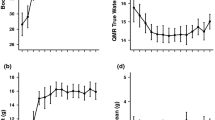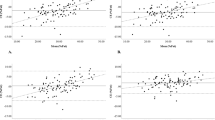Abstract
An ideal technology for non-invasive analysis of body composition should provide highly precise and accurate direct measurements of fat, lean mass and total water of non-anaesthetized subjects within minutes. We validate a quantitative magnetic resonance (QMR) body composition analyzer for birds using House Sparrows (Passer domesticus), European Starlings (Sturnus vulgaris), and Zebra Finches (Taeniopygia guttata). Subjects were scanned awake for three replicate scans of 1.5–3.5 min, and results were compared to gravimetric chemical analysis. Coefficients of variation were ≤3% for dry fat, wet lean mass and total water. Accuracy of the raw QMR data for fat and total water were high (relative errors ≤±12.5 and ≤±4%, respectively), but wet lean mass was significantly biased because QMR does not detect structural tissues. Calibration against gravimetric chemical analysis removed bias and improved accuracy; relative errors were ±6–11% for fat, ±1–2% for wet lean mass, and ±2–4% for total water. QMR is field-portable when transported in a temperature-controlled trailer, and can be used to study fuel storage and body composition dynamics during migration, reproduction, nestling growth, or wintering. In the laboratory, QMR can be used for longitudinal studies of birds under photoperiod, endocrine or other manipulations. Measurements taken before and after metabolic challenges, such as flight in a wind tunnel, make it possible to calculate energy costs, fuel selection and changes in hydration. QMR should find wide application in field and laboratory studies.
Zusammenfassung
Methoden für nichtinvasive Körperzusammensetzungs-Analysen sollen im Idealfall präzise und direkte Bestimmungen von Fett- und fett-freier Masse sowie dem totalen Wasseranteil von nichtanästisierten Tieren innerhalb von Minuten erlauben. Wir validieren eine quantitative Magnet-Resonanz (QMR) Körperzusammensetzungs-Analyse für Vögel anhand von Haussperling (Passer domesticus), Star (Sturnus vulgaris), und Zebrafink (Taeniopygia guttatai). Die Vögel wurden im wachen Zustand dreimal 1.5 bis 3.5 Minuten lang gemessen, und die Ergebnisse wurden mit einer chemischen Analyse verglichen. Variationskoeffizienten waren ≤ 3% für Fett (ohne Wasser), fett-freie Masse (mit Wasser) und für den gesamten Wasseranteil. Die Präzision der rohen QMR Daten für Fett und Wasseranteil war hoch (relative Messfehler: ≤±12.5% und ≤±4%), aber die Messung von fett-freier Masse (ohne Wasser) war beeinträchtigt, weil QMR keine strukturellen Gewebe erfasst. Die Kalibrierung mit chemischer Analyse behob dieses Problem und erhöhte die Genauigkeit; die relativen Messfehler waren ±6–11% für Fett, ±1–2% für fett-freie Masse (mit Wasser), and ±2–4% für den gesamten Wasseranteil. QMR findet Anwendung bei der Feldarbeit, um Fettdeposition während des Zuges, der Reproduktion, des Nestlingswachstum oder beim Űberwintern zu bestimmen. QMR kann auch im Labor angewandt werden, wenn z.B. die Photoperiode oder das Hormonsystem übere längere Zeiträume manipuliert werden. Messungen, die vor und nach Manipulation des Stoffwechels stattfinden, wie z.B. nach einem Flug in einem Windtunnel, ermöglichen es, Energiekosten, Brennstoffzusammensetzung und Veränderungen im Hydrationszustand zu berechnen.


Similar content being viewed by others
References
Bäckman J, Pettersson J, Sandberg R (1997) The influence of fat stores on magnetic orientation in day-migrating chaffinch, Fringilla coelebs. Ethology 103:247–256
Bauchinger U, Wohlmann A, Biebach H (2005) Flexible remodeling of organ size during spring migration of the garden warbler (Sylvia borin). Zoology 108:97–106
Berthold P, Elverfeldt D, Fiedler W, Hennig J, Kaatz M, Querner U (2001) Magnetic resonance imaging and spectroscopy (MRI, MRS) of seasonal patterns of body composition: a methodological pilot study in white storks (Ciconia ciconia). J Ornithol 142:63–72
Boyle WA, Norris DR, Guglielmo CG (2010) Storms drive altitudinal migration in a tropical bird. Proc R Soc Lond B 277:2511–2519
Cochran WW, Mouritsen H, Wikelski M (2004) Migrating songbirds recalibrate their magnetic compass daily from twilight cues. Science 304:405–408
Fleissner G, Holtkamp-Rötzler E, Hanzlik M, Winklhofer M, Fleissner G, Petersen N, Wiltschko W (2003) Ultrastructural analysis of a putative magnetoreceptor in the beak of homing pigeons. J Comp Neurol 458:350–360
Fransson T, Jakobsson S, Johansson P, Kullberg C, Lind J, Vallin A (2001) Magnetic cues trigger extensive refueling. Nature 414:35
Ganssen A (1989) Principles of NMR techniques. In: Kallweit E, Henning M, Groeneveld E (eds) Application of NMR techniques on the body composition of live animals. Elsevier, London, pp 3–21
Gerson AR, Guglielmo CG (2011) House sparrows (Passer domesticus) increase protein catabolism in response to water restriction. Am J Physiol Regul Integr Comp Physiol 300:R925–R930
Green AJ (2001) Mass/length residuals: measures of body condition or generators of spurious results? Ecology 82:1473–1483
Guglielmo CG, Williams TD (2003) Phenotypic flexibility of body composition in relation to migratory state, age and sex in the western sandpiper. Physiol Biochem Zool 76:84–98
Hayes JP, Shonkwiler JS (2001) Morphometric indicators of body condition: worthwhile or wishful thinking? In: Speakman JR (ed) Body composition analysis of animals. Cambridge University Press, Cambridge, pp 8–38
Hedenström A, Fagerlund T, Rosén M, Wirestam R (2009) Magnetic resonance imaging versus chemical fat extraction in a small passerine, the willow warbler Phylloscopus trochilus: a fat-score based statistical comparison. J Avian Biol 40:457–460
Karasov WH, Pinshow B (1998) Changes in lean mass and in organs of nutrient assimilation in a long-distance passerine migrant at a springtime stopover site. Physiol Zool 71:435–448
Korine C, Shai D, van Tets IG, Yosef R, Pinshow B (2004) Measuring fat mass in small birds by dual-energy x-ray absorptiometry. Physiol Biochem Zool 77:522–529
McFarland CN, Bendell-Young LI, Guglielmo CG, Williams TD (2002) Kidney, liver and bone cadmium concentrations in the western sandpiper in relation to migration. J Environ Monit 4:791–795
McGuire LP, Guglielmo CG (2010) Quantitative magnetic resonance: a rapid, non-invasive body composition analysis technique for live and salvaged bats. J Mammal 91:1375–1380
Mora MA, Rourke J, Sferra SJ, King K (2003) Environmental contaminants in surrogate birds and insects inhabiting southwestern willow flycatcher habitat in Arizona. Stud Avian Biol 26:168–176
Muheim R, Åkesson S, Phillips JB (2007) Magnetic compass of migratory savannah sparrows is calibrated by skylight polarization at sunrise and sunset. J Ornithol 148:S485–S494
Muheim R, Phillips JB, Deutschlander ME (2009) White-throated sparrows calibrate their magnetic compass by polarized light cues during both autumn and spring migration. J Exp Biol 212:3466–3472
Nagy TR (2001) The use of dual-energy x-ray absorptiometry for the measurement of body composition. In: Speakman JR (ed) Body composition analysis of animals. Cambridge University Press, Cambridge, pp 211–229
Nagy TR, Clair A-L (2000) Precision and accuracy of dual-energy x-ray absorptiometry for determining in vivo body composition of mice. Obes Res 8:392–398
Ohira Y, Ito A, Ikawa S (1977) Correction of water content and solute concentration in blood during hemoconcentration. J Appl Physiol Resp Environ Exer Physiol 42:739–743
Piersma T, Klaassen M (1999) Methods of studying the functional ecology of protein and organ dynamics in birds. In: Adams NJ, Slowtow RH (eds) Proceedings of the 22 international ornithological congress, Durban, BirdLife South Africa, Johannesburg, pp 36–51
Piersma T, Gudmundsson GA, Lilliendahl K (1999) Rapid changes in the size of different functional organ and muscle groups during refuelling in a long-distance migrant shorebird. Physiol Biochem Zool 72:405–415
Rae LF, Mitchell GW, Mauck RA, Guglielmo CG, Norris DR (2009) Effects of radio transmitters on the body condition of Savannah Sparrows during the fall pre-migratory period. J Field Ornithol 80:419–426
Reynolds DS, Kunz TH (2001) Standard methods for destructive body composition analysis. In: Speakman JR (ed) Body composition analysis of animals. Cambridge University Press, Cambridge, pp 39–55
Schaub M, Jenni L, Bairlein F (2008) Fuel stores, fuel accumulation, and the decision to depart from a migration stopover site. Behav Ecol 19:657–666
Scott I, Mitchell PI, Evans PR (1996) How does variation in body composition affect basal metabolic rate of birds? Funct Ecol 10:307–313
Scott I, Selman C, Mitchell PI, Evans PR (2001) The use of total body electrical conductivity (TOBEC) to determine body composition in vertebrates. In: Speakman JR (ed) Body composition analysis of animals. Cambridge University Press, Cambridge, pp 127–160
Seewagen CL (2008) An evaluation of condition indices and predictive models for non-invasive estimates of lipid mass of migrating common yellowthroats, ovenbirds and Swainson’s thrushes. J Field Ornithol 79:80–86
Seewagen CL, Guglielmo CG (2010) Effects of fat and lean body mass on migratory landbird stopover duration. Wilson J Ornithol 122:82–87
Seewagen CL, Guglielmo CG (2011) Quantitative magnetic resonance analysis and a morphometric predictive model reveal lean body mass changes in migrating nearctic-neotropical migrating passerines. J Comp Physiol B 181:413–421
Seewagen CL, Slayton EJ, Guglielmo CG (2010) Passerine migrant stopover duration and spatial behaviour at an urban stopover site. Acta Oecol 36:484–492
Speakman JR, Visser GH, Ward S, Król E (2001) The isotope dilution method for the evaluation of body composition. In: Speakman JR (ed) Body composition analysis of animals. Cambridge University Press, Cambridge, pp 56–98
Stapput K, Thalau P, Wiltschko R, Wiltschko W (2008) Orientation of birds in total darkness. Curr Biol 18:602–606
Taicher GZ, Tinsley FC, Reiderman A, Heiman ML (2003) Quantitative magnetic resonance (QMR) method for bone and whole-body-composition analysis. Anal Bioanal Chem 377:990–1002
Vézina F, Jalvingh KM, Dekinga A, Piersma T (2006) Acclimation to different thermal conditions in a northerly wintering shorebird is driven by body mass-related changes in organ size. J Exp Biol 209:3141–3154
Wikelski M, Tarlow EM, Raim A, Diehl RH, Larkin RP, Visser GH (2003) Costs of migration in free-flying songbirds. Nature 423:704
Williams NM, Wild JM (2001) Trigeminally innervated iron-containing structures in the beak of homing pigeons, and other birds. Brain Res 889:243–246
Wingfield JC, Hahn TP, Wada M, Schoech SJ (1997) Effects of day length and temperature on gonadal development, body mass, and fat depots in white-crowned sparrows, Zonotrichia leucophrys pugetensis. Gen Comp Endocrinol 107:44–62
Wirestam R, Fagerlund T, Rosén M, Hedenström A (2008) Magnetic resonance imaging for noninvasive analysis of fat storage in migratory birds. Auk 125:965–971
Zapka M, Heyers D, Hein CM, Engels S, Schneider N-L, Hans J, Weiler S, Dreyer D, Kishkinev D, Wild JM, Mouritsen H (2009) Visual but not trigeminal mediation of magnetic compass information in a migratory bird. Nature 461:1274–1277
Acknowledgments
We are grateful to Echo Medical Systems and Glendale RV for working with us to customize and troubleshoot a QMR system and an RV trailer. In particular, we thank G. Taicher, B. Burdette, G. Fischel, I. Kovner, V. Rubin and G. Marra for their efforts. We thank E. Price and S. MacDougall-Shackleton for helping us to obtain birds, D. Cerasale for measuring bird skeletons, Y. Morbey for programming simulations in SAS, and H. Mouritsen for insight into the potential effects of magnetic fields. Thanks to S. Nebel for German translation. Funding was provided by an NSERC Discovery Grant to C.G.G., grants from the Leaders Opportunity Fund of the Canada Foundation for Innovation and the Ontario Research Fund to C.G.G. and E. MacDougall-Shackleton, and in-kind contributions from Echo Medical Systems and Glendale RV.
Author information
Authors and Affiliations
Corresponding author
Additional information
Communicated by L. Fusani.
Rights and permissions
About this article
Cite this article
Guglielmo, C.G., McGuire, L.P., Gerson, A.R. et al. Simple, rapid, and non-invasive measurement of fat, lean, and total water masses of live birds using quantitative magnetic resonance. J Ornithol 152 (Suppl 1), 75–85 (2011). https://doi.org/10.1007/s10336-011-0724-z
Received:
Revised:
Accepted:
Published:
Issue Date:
DOI: https://doi.org/10.1007/s10336-011-0724-z




